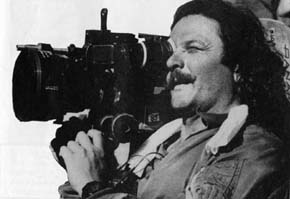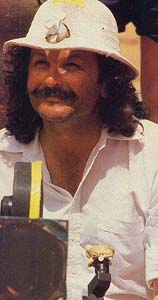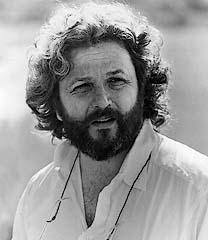 George Miller was born in 1945, moments apart from his twin brother John, in Brisbane, Queensland, Australia. He grew up in the tiny Australian town of Chinchilla (population 400)
where "the only experience of the outside world was the Saturday matinee."
George Miller was born in 1945, moments apart from his twin brother John, in Brisbane, Queensland, Australia. He grew up in the tiny Australian town of Chinchilla (population 400)
where "the only experience of the outside world was the Saturday matinee.""I grew up in a country town way out in the middle of Australia and there I turned into a typical film freak. You know, Saturday matinees. I'd always go to the movies. Being that I didn't have television in those days, I'd act it out. If there was a Phantom serial, I'd dress up as the Phantom, and if it was Galahad we'd have chainmail and jousting competitions and really quite elaborate games. And of course I was addicted to comic books and I did a lot of drawing. So there has been all that sort of stuff which I'm sure has been very useful for now. As a filmmaker you can use that sort of stuff. My parents and teachers would accuse me of being quite illiterate because I'd only read comic books and go to movies and that sort of thing."
After the family moved to Sydney, George and his twin attended high school and even medical school (at the University of New South Wales) together . George often went to morning sessions of the movies while his brother went to classes and took notes for them both.
In 1971, the brothers were about to graduate from medical school when they entered a one-minute film in a student competition and won. The prize was a course at the Melbourne Film Workshop. John remained in medicine, but George chose to attend the film course. It was there that he met fellow student Byron Kennedy, and they collaborated on screenplays and experimental short films. In 1972, while Miller completed his residency at Sydney's St.Vincent's Hospital, he and Kennedy pooled their every cent (for a tally of $1,500) to make Violence In The Cinema - Part One.
 "There was very little filmmaking in Australia up until around 1971, so anyone who could pick up a camera and wave it around was making films, but it was never very much on a professional level except
in television. At that stage I made some low budget experimental films, short subjects, with Byron
[Kennedy]. One was a 15 minute 16mm film called Violence In The Cinema - Part One. At that
time there was a lot of controversy about cinema violence, Clockwork Orange, Sam Peckinpah, and there seemed to be a lot of writing about, a lot of intellectualizing and a lot of talk but very little
understanding. My film was a little parody on cinema violence where a kind of pundit, an expert,
lectured very sternly about his theories on cinema violence, and while he was doing this, all different
samples of cinema violence happened to him --- very stylized, slow-motion gunshot things and very
visceral, getting blown up and thrown out of buildings and being mutilated, but nothing stopped him from giving this lecture. It was a strange, surreal little film, but it had its point which was basically fairly anti-intellectual about looking at cinema violence and saying how does each individual topic affect you for yourself. It was interesting for me at the time and that film kind of got us kicked off. It was shown at the Cannes Film Festival as a short subject."
"There was very little filmmaking in Australia up until around 1971, so anyone who could pick up a camera and wave it around was making films, but it was never very much on a professional level except
in television. At that stage I made some low budget experimental films, short subjects, with Byron
[Kennedy]. One was a 15 minute 16mm film called Violence In The Cinema - Part One. At that
time there was a lot of controversy about cinema violence, Clockwork Orange, Sam Peckinpah, and there seemed to be a lot of writing about, a lot of intellectualizing and a lot of talk but very little
understanding. My film was a little parody on cinema violence where a kind of pundit, an expert,
lectured very sternly about his theories on cinema violence, and while he was doing this, all different
samples of cinema violence happened to him --- very stylized, slow-motion gunshot things and very
visceral, getting blown up and thrown out of buildings and being mutilated, but nothing stopped him from giving this lecture. It was a strange, surreal little film, but it had its point which was basically fairly anti-intellectual about looking at cinema violence and saying how does each individual topic affect you for yourself. It was interesting for me at the time and that film kind of got us kicked off. It was shown at the Cannes Film Festival as a short subject."Violence In The Cinema - Part One won two Australian Film Institute Awards and was presented at the Sydney and Moscow Film Festivals. That same year, the production company, Kennedy Miller was formed, with an eye toward making full-length feature films.
With no government support, it took Kennedy Miller seven years to gather the $350,000 needed to make Mad Max. During this frustrating period, Miller earned his keep as a doctor and Kennedy as a cameraman. Ultimately, the time and financial investment paid off handsomely as Mad Max became an international hit, won the Special Jury Prize at Avoriaz and led to The Road Warrior (1981).
 In 1982, Rupert Murdoch, who had just purchased Australia�s Channel 10, made Kennedy Miller an offer they couldn�t refuse: "Do anything you want for us as long as it�s bold." As a result, Miller produced and co-wrote The Dismissal (1982), a six-hour miniseries on the 1975 Australian
constitutional crises that broke ratings records.
In 1982, Rupert Murdoch, who had just purchased Australia�s Channel 10, made Kennedy Miller an offer they couldn�t refuse: "Do anything you want for us as long as it�s bold." As a result, Miller produced and co-wrote The Dismissal (1982), a six-hour miniseries on the 1975 Australian
constitutional crises that broke ratings records.That same year, Steven Spielberg approached Miller about directing a segment of Twilight Zone: The Movie (1983). Miller's episode, "Nightmare at 20,000 Feet" went on to earn the highest praise and is now singled out as a cult classic.
Following Kennedy�s tragic death in a helicopter accident in 1983, Miller forged into an intensive work spurt that included two ten-hour miniseries: Bodyline and The Cowra Breakout. After the unsatisfying experience of directing The Witches of Eastwick (1987) for an American studio, he turned to producing. During a five-year period, Kennedy Miller produced two John Duigan films (The Year My Voice Broke (1987) and Flirting (1991)), Dead Calm (1989) and two miniseries. Miller returned to directing with Lorenzo�s Oil (1992), which he co-wrote with Nick Enright, earning them an Academy Award nomination for the screenplay.
Most recently, he produced and co-wrote Babe (1995), which won the National Society of Film Critics' Best Film award, the Golden Globe Award for Best Musical or Comedy and the Academy Award for Best Visual Effects. Babe was also nominated for 6 other Oscars, including Best Picture. Currently, work is underway to develop a Mad Max TV series and possibly a fourth Mad Max film (though the latter project is unconfirmed).
